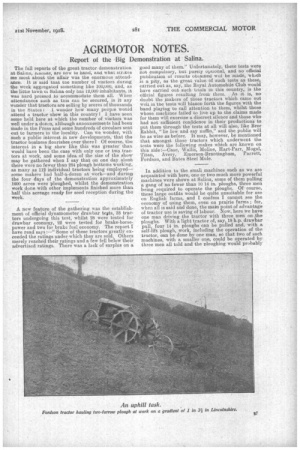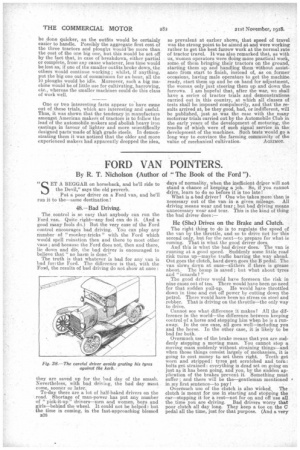AGRIMOTOR NOTES.
Page 17

Page 18

If you've noticed an error in this article please click here to report it so we can fix it.
Report of the Big Demonstration at Salina.
The full reports of the great tractor demonstration. at Salina, .n.aubas, are now to hand, and what strikes me most about the affair was the enormous .attendwee. it is said tnat the number of visitors during the week aggregated something like 100,000, and, as the little town oi Salina only has 12,000 inhabitants, it was hard pressed _to accommodate them all. When attendances such as this can be secured, is it any wonder that tractors are selling by scores of thousands in the States f I wonder how many people would attend a tractor show in this country 1 have seen some held here at which the number of visitors was well under a dozen, although announcements had been made in the Press and some hundreds of circulars sent out to farmers in the locality. Can we wonder, with auch a public interest in new developments, that the tractor business flourishes over there 1 Of course, tho interest in a big show like this was greater than would have been the case with only one or two tractors at work, and some idea of the size of the show may be gathered when I say that on one day alone there were no fewer than 284 plough bottoms working, as many as 112 individual tractors being employed— some makers had half-a-dozen at work.--and during the four days of the demonstration approximately 1600 acres were ploughed, whilst the demonstration work done with other implements finished more than half this acreage ready for seed reception during the week.
A new feature of the gathering was the establishment of official dynamometer drawbar teats, 38 tractors undergoing this test, whilst 28 were tested for drawbar economy, 22 were tested for brake-horsepower and two for brake fuel economy. The report I have read says :—" Some of these tractors greatly exceeded the ratings under which they are sold. Others merely reached their ratings and a few fell below their advertised ratings. There was a lack of surplus on a good many of them." Unfortunately, those tests were not compulsory, but purely optional, and no official publication of results obtained will be made, which is a pity, as the great value Of such tests as these, carried out as, say, the Royal Automobile Club would have carried out such trials in this country, is the official figures resulting from them. As it is, no doubt the makers of those tractors which came out well in the tests will blazon forth the figures with the band playing to call attention to them, whilst those whose machines failed to live up to the claims made for them will exercise a discreet silence and those who had not sufficient confidence in their production's to put them through the tests at all will also, like Brer Rabbit, "lie low and say nuffin," and the public will be as wise as before. It may, however, be mentioned that amongst those tractors which underwent the tests were the following makes which are known on this side :—Case, Wallis, Moline, Hart-Parr, Mogul, Titan, Avery, Emerson-Bran tinghitm, Parrett, Fordson, and Bates Steel Mule.
La addition to the small machines such as we are acquainted with here, one or two much more powerful machines were shown at Salina, some of them pulling a gang of no fewer than 10 14 in. ploughs, three men being required to operate the ploughs. Of course, these large outfits would be quite unsuitable for use on English farms, and I confess I cannot see the economy of using them, even on prairie farms ; for, when all is said and done, the main point of advantage of tractor use is saving of labour. /slow, here we have one man driving the tractor with three men on the ploughs. With a light tractor of, say, 18 h.p. drawbar pull, four 14 in. ploughs can be pulled and, with a self-lift plough, work_, including the operation of the tractor, can be done by one man, so that two of such machines, with a smaller one, could be operated by three men all told and the ploughing would probably
be done quicker, as the outfits would be certainly easier to handle. Possibly the aggregate first cost of the three tractors and ploughs would be more than the cost of the one big one, but this would be set off by the fact that, in case of breakdown, either partial or complete, from any cause whatever, less time would be lost as, if one of the smaller outfits broke down, the others would continue working ; whilst, if anything, put the big one out of commission for an hour, all the 30 ploughs would be idle. Moreover, such a big machine would be of little use for cultivating, harrowing, etc., whereas the smaller machines could do this class of work well.
One or two interesting facts appear to have come out of these trials, which are interesting and useful. Thus, it was shown that the tendency in manufacture amongst American makers of tractors is to follow the lead of the automobile makers and abolish heavy iron castings in favour of lighter and more scientifically designed parts made of high grade steels. In demonstrating them it was noticed that the older and more experienced makers had apparently dropped the idea, so prevalent at earlier shows, that speed of travel was the strong point to be aimed at and were working rather to get the best furrow work at the normal rate of tractor travel. It was also remarked that, as with us, women operators were doing more practical work, some of them bringing their tractors on the ground, starting them up and handling them without assistance from start to finish, instead of, as on former. occasions, having male operators to get the machine ready, start them up and be on hand for adjustment, the woman only just steering them up and down the furrows. I am hopeful that, after the war, we shall have a series of tractor trials and demonstrations carried out in this country, at which all classes of tests shall be imposed compulsorily, and that the results arrived at, be they good, bad, or indifferent, will be published, just as was the case with the many motorcar trials carried out by the Automobile Club in the early years of the development of motoring, the results of which were of such signal service in the development of the machines. Such tests would go a long way to convince the farming community of the
value of mechanical cultivation. A






















